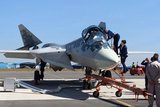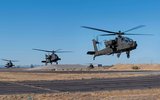Culdrose squadrons in Afghanistan
Based at Royal Naval Air Station Culdrose are three helicopter squadrons which specialise in Airborne Surveillance and Control (ASaC).
849 Naval Air Squadron is the HQ and training squadron, with 854 and 857 squadrons forming the “front line” or operational squadrons which deploy on operations, currently to Afghanistan.
The airborne surveillance and control capabilities of the aircraft are proving invaluable in the war against terrorism and before deploying to Afghanistan, all members of the squadrons go through a series of rigorous courses and assessments to ensure their preparedness for operations.
All personnel must be proficient with the SA80 A2 assault rifle and aircrew are also trained in the use of sidearms. Additionally, the aircrew are trained in “downbird” drills to ensure that they can protect themselves and the aircraft if forced to land in the desert for any reason.
In Afghanistan, Camp Bastion airfield is 3000 feet above sea level and this has an impact in terms of both helicopter operations and on maintenance personnel who have to work in temperatures of up to 45 degrees C.
The first few days after a squadron arrives at Camp Bastion are spent re-qualifying the aircrew in dust landings and re-familiarising with the complex airspace in and around Bastion Airfield before commencing operations.
The ASaC engineering personnel have a close working relationship with Commando squadrons’ engineers who operate the Sea King Mk4 Helicopter, working together when required to enable both squadrons to maximise their serviceability rates.
The squadrons soon settle into a routine with the engineers working 12 hour shifts and the aircrew fly Ops as required by the Command, often launching on 6 hour missions requiring double refuels in support of the United States Marine Corps and other coalition partners. In terms of ‘off watch’ time, the teams make full use of the gym facilities to maintain fitness levels, and down time also enables crews to complete the various necessary secondary that come their way.
Although primarily a maritime aircraft, the ASaC helicopters have been adapted for use in the land environment using their powerful radar to track vehicle movement across the desert. The squadrons support land forces from both Task Force Helmand (UK) and Task Force Leatherneck (United States Marine Corps) in the south of the country and provide real time support to troops operating close to the Taliban’s strongholds.
At present 857 Naval Air Squadron is serving in Afghanistan and will be relieved by 854 Naval Air Squadron at the end of the year.
Source: Royal Navy
More from Defence Helicopter
-
![Germany to send WS-61 Westland Sea King helicopters to Ukraine]()
Germany to send WS-61 Westland Sea King helicopters to Ukraine
Germany has committed to sending Ukraine six of its 21 retiring WS-61 Westland Sea King multirole, amphibious helicopters.
-
![Boeing secures $271 million to advance modernisation of US Special Operations' MH-47G Chinook]()
Boeing secures $271 million to advance modernisation of US Special Operations' MH-47G Chinook
Boeing has clinched a major contract modification to further its backing of the US Special Operations Command’s MH-47G Chinook aircraft modernisation effort.
-
![Dubai Airshow 2023: South Korean homegrown helicopters make international debut]()
Dubai Airshow 2023: South Korean homegrown helicopters make international debut
Two KAI helicopters, the KUH-1E utility helicopter and the Light Attack Helicopter (LAH), have taken centre stage at the Dubai Airshow 2023.
-
![Italian Navy receives final NH90 helicopter]()
Italian Navy receives final NH90 helicopter
The Italian Navy now boasts a fleet of 56 NH90 helicopters comprising 46 SH-90As and 10 MH-90As.
-
![Argentina seeks AW109 and CH-46 Sea Knight helicopters]()
Argentina seeks AW109 and CH-46 Sea Knight helicopters
The Argentinian Air Force (FAA) and the Argentinian Naval Aviation Command (COAN) are looking for options to upgrade their helicopter fleets.
-
![DSEI 2023: Lockheed to produce about 40% of Black Hawks on UK soil if it wins NMH contest]()
DSEI 2023: Lockheed to produce about 40% of Black Hawks on UK soil if it wins NMH contest
Lockheed Martin promises a boost to the British job market and export opportunities, while strengthening ties with Poland and positioning the UK for a future in rotorcraft technology in the event of a New Medium Helicopter competition triumph.

























